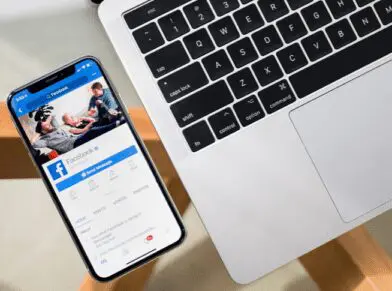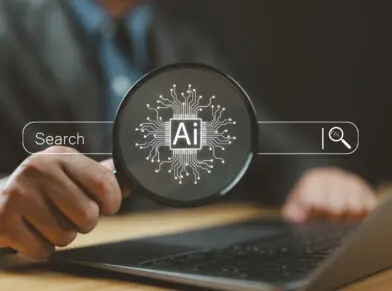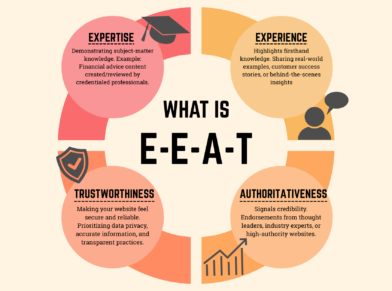WHAT IS SEO?
In a world where we are so often identified by what we do as who we are, being in SEO doesn’t always help people draw the most accurate picture of what I do or who I am. So in an effort to provide a frame of reference for our own clients, as well as potential clients, I wanted to take a minute and lay out the basic framework of SEO.
SEO is Search Engine Optimization, or literally the efforts made in helping your web site to appear more prominently in Search Engine results, ie Google. The reality of our world is when people have a need, of any type, they immediately use search to begin to solve their problem. Search, and more poignantly, Google, has changed the way in which the world accesses and judges information, in so much that whatever results are returned for a particular search, are generally viewed as the best or most appropriate results. The bottom line is regardless of the product you sell, the service you offer, whether you are a business-to-business industry or a consumer facing industry, people, your potential clients and customers, are searching for your product, for information about your product, for reviews, for specifications, searching for answers. SEO helps connect your business with those customers searching for you.
SEO is not a fixed concept, nor is it an agreed upon set of rules or best practices. SEO is a dynamic and evolving industry that has seen tumultuous change and redirection nearly every year. What does not change is the fundamentals of where SEO takes place and what Google looks to in order to help “rank” your site. These ranking factors may change in weight, or how google values each factor, as well as entirely new factors arising. When we talk about SEO and ranking factors we talk about 2 main things: On-Site & Off-Site.
On-Site
When we talk about On-Site we’re referring to the actual coding and elements of your website: How your content is structured and organized, the particular elemental tags used to differentiate content on your site, from the way you tag your images to the url structure and page types you employ. Quality SEO is diving into each page, having a clear goal in mind and a coordinated effort for all elements of the page towards the particular page goal.
Off-Site
The other main factor is what is happening in reference to your site, out in the web. So in addition to how you structure your content and label it, Google also wants to see some authority on the web with regard to your content. The best way of weighting the value of a site’s content is by evaluating the number of other sites that link to that particular page and/or domain. This is the essence of backlinks, or other sites that link back to your website. The type of link and value of each type vary widely, but what remains consistent is the need for quality backlinks in order to move the needle. In recent years we’ve seen the emergence of social media as a factor, with Google going as far as creating their own Social Media Network in order to try and leverage the power of search with the power of social.
Bottom line, SEO is an evolving industry, which is here to stay. There were nearly 20 billion searches in the US alone last month, and this number is rising, not decreasing. If you’re currently engaging on SEO, kudos. If you’re not, then do a couple of quick Google searches for a keyword in your industry. Take note of whom appears at the top of those results. While you’re not making the effort, your competitor is.
Look for our next article, “What to look for in an SEO firm”, due later this week and when results matter, GlobeRunner SEO.
JULY SEO UPDATE
Google Updates
After a silent June, Google announced 86 changes/updates to their search algorithm this past Friday. As usual, we are going to highlight the changes that we are most interested in because they result directly to how we optimize and grow our clients’ web presence. No matter the changes, we are keeping up with what effects your rankings. There are several updates reinforcing that fresh, unique, and useful content is of the utmost importance to continuing to rank well. These updates include:
- Bamse. [project codename “Page Quality”] This launch helps you find more high-quality content from trusted sources.
- Bamse-17L. [project codename “Page Quality”] This launch helps you find more high-quality content from trusted sources.
- GreenLandII. [project codename “Page Quality”] We’ve incorporated new data into the Panda algorithm to better detect high-quality sites and pages.
- #82353. [project codename “Page Quality”] This change refreshes data for the Panda high-quality sites algorithm.
- #82666. [project codename “Page Quality”] This launch helps you find more high-quality content from trusted sources.
- Hamel. [project codename “Page Quality”] This change updates a model we use to help you find high-quality pages with unique content.
- Lime. [project codename “Freshness”] This change improves the interaction between various search components to improve search results for searches looking for fresh content.
Google also announced a few changes to the way they are ordering search results with this update:
- ng2. [project codename “Other Ranking Components”] Better ordering of top results using a new and improved ranking function for combining several key ranking features.
There has not been a lot of information related to this change released yet, but we will be continuing to monitor how these changes will effect rankings in the coming months.
Press Releases and Penguin and Panda
Press releases are one of the strategies that we use at Globe Runner to build links to your website. We try to write these press releases about current events in your industry and relevant to your business. Our primary goal with these press releases is to gain high quality links. In the aftermath of the Penguin and Panda algorithm updates, this is still a valid strategy, however, it is even more important now that press releases for SEO be written as normal, media focused press releases and not just stuffed with links or as promotional pieces.
Mobile Update
Mobile searches are increasingly popular and have extremely high conversion rates. A study featuring 6000 mobile users stated that 85% of users who searched for a restaurant on their smartphone purchased within 24hrs of the search. Results like these are why we at Globe Runner stress the importance of optimizing our client’s local pages like Google+Local, Yelp, Foursquare, Yahoo, and Bing local pages.
Social Media Update
Social Media is often confusing and many of our customers wonder about the effectiveness of their actions. The following graph, published by MarketingSherpa in their 2012 Social Media Benchmark Report, shows the effectiveness of each tactic to achieve objectives vs. the degree of difficulty to accomplish the task. The size of the circles represents the percentage of companies taking these actions.
At Globe Runner SEO, we specialize in social media integration with search engine optimization. Current with the industry trends our social media strategy focuses on first optimizing your business’ social sites managing your social campaigns, and encouraging blogger relationships. These strategies ultimately build your brand credibility which builds authority which in turn boosts your rankings.
One final Social update, Google+ is finally rolling out vanity urls for their Google+ and Google+Local pages. At last, Google+ pages will show the name of the place in the url. For example, our vanity url will be google.com/+globerunnerseo. Unfortunately, this is a slow rollout by Google and right now only the biggest players like Toyota, Delta, and Britney Spears have received their vanity urls. Look for this optimization in the coming weeks or months. We are monitoring this update to make sure our clients’ profiles receive their vanity urls as soon as they are available.
Just for fun
At Globe Runner we are tech junkies and love our smart phones and as you can tell, we are very much Google-groupies, following all of Google’s updates very closely. One of the more fun recent updates we were excited about was the update that lets you handwrite your search queries on your smart phone or tablet.
During the Olympics the Google Doodles have been interactive games based on the Olympic sports and these games have been a fun source of office competition before our morning meetings. However, our favorite Doodle was this one featuring our office’s favorite team building activity.
JUNE 2012 SEO UPDATE
June updates included two Panda updates, version 3.7 and 3.8, a first Penguin refresh, but there hasn’t been much chatter about those updates meaning they were probably pretty minor. Google did confirm that links still carry more weight and are more important to your core rankings than social media. Also, there are no “No Follow Penalties” from Google for including several no follow links on a site.
Other updates in the search engine blog-o-sphere included talk about how to manage multiple listings or locations on your website without having too much duplicate content. For example, many of our clients own businesses with multiple locations throughout the Metroplex. A question we are often asked is, “Can we use the same information on each of our unique location pages?” Matt Cutts, Distinguished Engineer at Google, leading the webspam team, says that rather than repeat the whole history of the company or a long pitch, it is best to just list the address and contact information for the location and 2-3 sentences about what is unique to that location. This will prevent Google from flagging your site for too much duplicate content.
Google Product Search has now become Google Shopping. Google is for the first time discontinuing their free product shopping search in exchange for a “paid inclusion model.” A paid inclusion model is “a model where companies pay to be listed, but payment does not guarantee that they rank well for any particular terms.” Product listings will now need to be created through Google AdWords in campaigns for Google Shopping. If you are already running Product Listing Ads, then you will be familiar with the process because Google Shopping campaigns will be very similar, so similar in fact, that once Google Shopping is fully released, Product Listing Ads will be phased out. Google Shopping will offer benefits of allowing merchants to advertise their special deals and offers as well as present potential customers with better quality pricing information.
One change to the shopping experience you may notice right away is Google has shifted shopping results to the top right of the page as opposed to the top of the listings. This will help keep organic results at the top of the page. See the below for an example of a search I did for “laptop computers.”
PPC Update
Online Marketing continues to be a growing and evolving space. It’s been reported that in the 1st Quarter of 2012 online advertising spend increased 12%, a healthy growth rate. This should come as no surprise, if you’re reading this summary then you’ve already made online marketing a priority in your efforts and chances are your competition has as well.
Globe Runner Update
Monthly reports will now be sent out on the 15th of the month rather than the beginning of each month.
Resources
Interview with Matt Cutts about what makes a quality site
Google Product Search to become Google Shopping
2017 SEO PROJECTION
All right. 2017 is just right around the corner, and it’s time to do some projections. What do we see is coming in 2017? There’s going to be a lot of surprises, but here’s a couple things that I can tell you with a pretty good certainty you’ll see in 2017.
The first one I did in a previous video, artificial intelligence. It’s here. It’s here to stay. It’s going to be a big part of what consumers experience, particularly on the customer service side, and it’s something that you need to be looking into for your own business.
The next one is schema. Schema is not new in and of itself, but an emphasis on schema and a wider schema vocabulary is going to be an emphasis in 2017.
Just to take a step back, schema is a microformat, where I can markup my page with additional data and allow Google to learn more about it. So, you’ll see it in rich snippet searches, like recipe searches for instance. You’ll see an image and a rating and some of the top ingredients. You’ll see that in more and more categories. We’re already seeing it in some e‑commerce categories, restaurants and physical location categories. More categories you’re going to have schemas. That will be a 2017 addition.
Another one that people are seeing, and there’s some controversy, is native Google content. This is Google actually pulling content off of your website and not sending the user to you but rather giving user the answer on Google. So it’s native Google content, basically answering the question. If it’s a clear question, Google feels like they should be able to just answer the question. Now, this is good and bad. If you can figure out a way to game the system ‑‑ which, by the way, we’ve figured out some ways to game that system ‑‑ and get content to rank as native, you still are the top spot and you’ll get a good click‑through rate. Even though it’s controversial, we see it as a big boon.
The last one that I’ll talk about is site speed, particularly mobile. Mobile speed is huge and Google rolled out AMP earlier this year. This is a very big deal which stands for “Accelerated Mobile Pages”. I’ve talked about it in another video. Very, very important to be taking advantage of technologies like that so you have a very, very fast experience on your website.
That’s just a few things that are going to be critical in 2017, that need to be part of your strategy. If your marketing team isn’t talking about it already, you’re behind the times. Get in touch with us if you need help staying up with the times. That’s what we do. We would be glad to help you. Go to GlobeRunner.com, and I look forward hearing from you.
THE ALPHABET GAME ACCORDING TO GOOGLE
A is for Apple right? Well not according to Google, “A” is now for Amazon. Now using Google Instant search we can see the 26 most important search terms from A to Z. Today, we intend to revisit the subject of Google Instant Search since our first post when Instant was first announced by Google. In this article, we are going to discuss how Google Instant has affected the searcher and what that means for businesses working to improve their website’s search engine rankings. Through our research, we found that unlike a child’s random participation in the alphabet game, Google strives to purposefully deliver Instant Hints when a user begins typing the first letter. Businesses need to pay attention to this improvement in search, because Google Instant means potentially more impressions for your website especially if you are already ranking in the top three positions in the search results.
A = Amazon
B = Bank of America
C = Craigslist
D = Dictionary
E = Espn
F = Facebook
G = Google
H = Hotmail
I = iPhone 5
J = JC Penney
K = Kohls
L = Lowes
M = MapQuest
N = Netflix
O = Old Navy
P = Pandora
Q = Quotes
R = Redbox
S = Southwest Airlines
T = Target
U = USPS
V = Verizon Wireless
W = Walmart
X = X Factor
Y = YouTube
Z = Zillow
When Google introduced Instant Search, their goal was to deliver more relevant searches faster. This came in the form of autocomplete and instant hints which use both personal browsing data (what you’ve previously searched) and the browser’s physical location (IP address) to deliver search results. Autocomplete, as you may be already familiar, automatically completes your search phrase by delivering educated guesses in the search bar. Instant Hints appear in a short drop down list of phrases that relate (in theory) to your query. With this technology, Google has enabled the searcher to browse and click through results without having to finish typing a query or even clicking on the search button. Below is a list that I generated simply by typing in the following letters A-Z… this was more of a fun exercise rather than something we took seriously. However, as marketers who live, eat, breathe, sleep SEO, we couldn’t help but discover a few things…
It never hurts to be an established brand. If you already are attracting thousands of new visitors to your site every month, such as Amazon or Craigslist, Google may just include you as an Instant Hint automatically. This is perhaps the least actionable of my points, since Instant Hints are based primarily on the searcher’s history and recent trends, which brings me to my next point…
Online follows offline. For all you students of psychology, herd theory—the desire to be one with the crowd—does play out in the search engines. Google says that every Instant Hint is a term or phrase that someone (in your geographic area) has already typed in. Thus, Google assumes that what other people are searching is probably what you will likewise want to search. Ergo, herd theory, or the influence of “the crowd” on human decisions, is powerful for getting ranked well in search engines (especially Bing which has begun to exclusively use social media to deliver more relevant search results).
Trends are friends. Adding to my last point about Google displaying Instant Hints based on previous search behavior, trends or events that happen at a certain time of year can generate addition impressions (or better yet, traffic) for your business. Holidays and current events all can help to bolster your website or blog if you pick corresponding keywords and write great content. The higher quality content you have, the more likely you will be to actually generate traffic from these trending keywords and convert your site’s visitors.
It’s good to be Google or any of Google’s content networks: Wikipedia, YouTube, Plus, etc. This point is really more of a pun, since Google displayed itself under the letter “G” (actually displayed Google and Google News as the first two Hints). Nothing wrong with a little self-promotion.
We plan to discuss more about Google Instant in the days to come so keep in touch.
OVERSTOCK.COM BUSTED AGAIN – USING BLACK HAT SEO
Once again, Overstock.com is suspected of playing dirty.
Last February, Overstock.com was penalized by Google for manipulating the search engines. The online retailer offered students and faculty discounts in exchange for posting links from college and university websites to Overstock.com. Their motivation? Ranking in search engines are, in large part determined by assessing the number of sites that link back to the site being ranked. In order to avoid artificial influence on search engines, Google forbids sites from paying other websites to embed links on their pages, and penalized Overstock.com for this unethical (“black hat”) practice. The Wall Street Journal quotes Patrick Byrne, Overstock’s chief executive, as saying, “We understand Google’s position and have made the appropriate changes to remain within Google’s guidelines.”
But they might be at it again.
I made this discovery while working on a competitive analysis for a client who wanted to rank for the keyword “kids’ bedding”. The top organic position was held by Overstock.com with this page: www.overstock.com/Home-Garden/Kids-Bedding/5389/subcat.html. My browser tools indicated the page had a large number of backlinks, an unusually large number for even a large retailer. I looked further. Using Open Site Explorer I found they had some very suspicious backlinks, including:
- http://stevesloanmusic.com/3comp_.html
- http://essencenet.ca/mainp.html
- http://dvihome.com.au/wp-admin/includes/co_mma.html
All of the above pages follow the same basic format. They’re branded to look like part of Overstock.com and filled with anchor text links that guide users back to the Overstock site. The pages themselves, though, are hosted on sites that are unrelated to Overstock or its products, including the websites of a writer, a musical composer, and an Australian photography and printing service.
The pages listed above are not the only suspicious-looking ones. Many of Overstock.com’s top-ranking pages have similar backlink profiles. You can check them out yourself using keywords like “Egyptian cotton sheets”, “sateen sheets”, “bedspreads”, “kids’ bedding”, and “bathrobes.” You’ll find many more.
Based on my years of industry experience, this type of activity seems to be as “black hat” as it gets. I can imagine two scenarios that might explain these links:
- These are paid links, and the sites’ webmasters allowed Overstock.com to post the pages.
- The sites were hacked, and the pages were placed on the sites without the webmasters’ knowledge.
Either way, the Overstock pages on these sites appear very suspicious. Overstock.com, whether intentionally or not, is clearly violating Google’s webmaster guidelines again. Based on these guidelines, I am curious to see how long it will take Google to serve up another penalty.
Overstock.com may or may not be aware of these pages. The world of Internet Marketing is full of miscommunications, implementation errors, and newly developed techniques that might be considered “grey hat”. We don’t want to accuse Overstock of trying to manipulate search engines again, but only bring attention to these questionable SEM tactics.
What’s your take on this issue? I’d like to hear your viewpoint. Please leave your thoughts in the comment section below.
ANATOMY OF AN ORGANIC TREND, OR “WHAT I LEARNED FROM #ZEBRAGIRL”
I spend most of my day signed into Twitter (I hate leaving it behind when I leave my desk) and have my Trending Topics set to Dallas-Fort Worth. Cody our Internet marketing specialist pointed out to me that #ZebraGirl was trending, and neither of us knew what that was, let alone how it ended up the third-most popular topic on Twitter for DFW.
It took awhile looking through the search results for #zebragirl to figure out why people were talking about it, but Cody and I quickly discovered people were talking about a girl on the campus of the University of North Texas in Denton who was wearing a two piece black and white outfit in a psychedelic print, and they had nicknamed her Zebra Girl. People sent in “sightings” of Zebra Girl, and there seemed to be an unwritten rule that someone SHOULD tell her, but no one was going to.
In an hour or so since it began, it has become the second highest trending topic, second only to Promoted Trend #subwayfan. It’s trending higher than “Marvin’s Room”, the name of a new single by hip-hop artist Drake which was organically trending nationally. Someone was tweeting about this girl every ten seconds, and that’s not even at the peak of the trend.
The trick to this becoming an organic trend was that it was left alone, just like any other piece of bad PR. But in this case there was also a mystery- who was this girl? Where was she going? People were out on campus trying to spot her. If this were guerrilla marketing, she’d have some sort of reward for those who found her in the form of a promotion or free product. But the authenticity here is what’s keeping the trend going and why people have been talking about a pair of leggings all afternoon. This wouldn’t continue if people were trying to find the BRAND NAME Zebra Girl Spokesperson. It wouldn’t be fun OR funny to find her around campus. The allure is in the idea that her outfit looks insane and she ostensibly doesn’t know.
Authentic intrigue is the key to establishing a social media trend. Upset the ordinary and people will talk about you. Both Alamo Drafthouse and NYC restaurant Jo’s have figured this out recently by creating the best anti-texting PSA ever and writing a scathing rebuttal to a Yelp Review respectively. They threw out “business as usual” (some people might argue it flies in the face of “the customer is always right” to tell people their business isn’t welcome if they act up) and it got them serious attention. You’d think this would be an obvious proposition, but the common approach seems to be “sneak in the marketing and see if they notice” a la Virgin Mobile’s new “Sparah” campaign. You can’t tell me Ashton Kutcher was really excited about that.
No, the hardest thing to do in social media is simply to be interesting, and too many people afraid to be different. But go against the norm, and organic trends are yours.
HOW WILL SCHEMA.ORG AFFECT SEO?
Google, Bing and Yahoo announced today that they all were adopting a new extended markup called schema.org.
This extended markup allows webmasters to add additional markup to their site to help search engines better understand their content.
The elements of your site that you can use the schema.org markup on are:
- Creative works: CreativeWork, Book, Movie, MusicRecording, Recipe, TVSeries …
- Embedded non-text objects: AudioObject, ImageObject, VideoObject
- Event
- Organization
- Person
- Place, LocalBusiness, Restaurant …
- Product, Offer, AggregateOffer
- Review, AggregateRating
Google has a rich snippets testing tool that will validate the code on your site.
We here at Globe Runner SEO anticipate that sites which utilize the schema.org markup will see increased traffic as the search engines more accurately place pages in search results. Search engines will give natural preferences to pages that give a clear window into their content.
Transcription
Eric McGehearty: Hi, it’s Eric with Globe Runner SEO, and I want to talk about something new, it’s Schema.org. Today Google Bing announced jointly that they were going to use Schema.org. Schema.org is basically very similar to what I’ve talked about before, which is microformats.
It’s a language system, it’s an add on system to an HTML markup that you would have on your page and your website page that Google, Bing, Yahoo have all agreed to use. It’s going to continue to grow, it’s going to be a library of markups that we can add to a webpage. The whole idea is to make search engines smarter so they can better engage with your content.
Honestly, it’s really not that complicated. There are extra codes, extra tags that I can put next to specific types of elements that allows a search engine a greater depth of understanding. So for instance, the example that they give on Schema.org is “Avatar”. If I put in my website a headline that said “Avatar”, how does the search engine know that I want to talk about the movie “Avatar” or if I’m talking about an avatar for representing a person’s face, right? How do they know?
Well, I could put in, from Schema.org, these additional microformats that would then tell the search engine, “This page is about the movie ‘Avatar’.” I want to also put in some extra text in there and I could in a person’s name and I could specifically label that name using the microformats and say, “And the director is,” right? So I’m able to actually tell the search engine all the nitty gritty details about the pieces of content on my page.
Here’s what’s neat microformats have been used been used for a little while, but the initial push of microformats was, for instance, reviews were a big push on microformats so that the search engine could put star ratings next to search results. That’s certainly still part of it, but now there’s an emphasis on people, places and things as well. Events are still part of it, that was part of the initial microformats rollout.
Today, if you have a company page and you have your employee page, you can add microformats in there to say, “This is a person. Here’s their email address, here’s their contact information,” things like that. If you’re a small business, a local business, or if you have locations of any kind, this is a really great opportunity to tag your location. You can tag your phone number, you tag your address, tag your business name, and you can really optimize that content so that the search engine really understands that you’re referring to yourself.
Also, let’s say that you had your address and then an alternative location on that same page. Well, you want to make sure that you tag your address properly so in local search results you come up, but that other addresses on the page are tagged differently to represent that those are representing other places on web, other things that you’re listing on your page. So there’s a lot of ways you might think about using it.
There was one that I found particularly interesting as an SEO person. There’s actually a way, using these microformats, to indicate a link without having a clickable link on your page. So, for instance, if I was referencing something, and I wanted to reference the Wikipedia article so Google knew that I was talking about this specific thing that Wikipedia is talking, I could do that without linking to Wikipedia.
I don’t actually affect the user experience, the user doesn’t even see a link, there’s no clickable text on my page, but Google sees that there’s a link out to Wikipedia. That would almost certainly affect search results in the same way that links now affect search results as a vote or passing credibility.
So Schema.org, visit it. If you’re a web developer and you’re interested in SEO, it’s a must have. You must learn this stuff if you want to stay on the cutting edge. Here at Globe Runner, of course, we’re staying on the cutting edge for our clients, and we’re excited to start integrating this in. It was announced this morning and I look forward to talking to you again soon.
SOCIAL SEARCH
If you’ve done a search on Bing or Google recently, you may have noticed the addition of “social circle” qualities included within the search results. For example, links that have been “liked” by members of your Facebook network may be pushed towards the top of the search results when searching with Bing. Or, if you’re using Google, you may see links that have been shared by members of your Twitter network included within the search results. This new feature of a social search allows a user to view more personally relevant results determined by the user’s social networks, making results unique to each person who has their own network of friends. Traditional search algorithms are used alongside the new social search feature, so search results will still appear normal if not shared or liked by anybody in your social network.
Through research, Bing states in a recent blog post that 90% of consumers look to their family and friends when making a purchase decision, and almost 80% of consumers will postpone a purchase decision until getting approval from a friend. Adding social qualities within the search results creates more of a conversational aspect to the search process, using the collective knowledge of the web as opposed to only facts and inbound links. Your friends, and the global community, can now help you discover information that is more relevant to you.
There was one issue with Bing’s social search that I found misleading when searching for a particular product. After searching for a specific product category, like cameras, it appeared on the search results page that a handful of my friends on Facebook liked some of the camera product pages on certain websites. In reality, that was not the case. My Facebook friends only liked the parent website that the products are listed under, i.e. Overstock.com, and not the actual product page. This may fool some consumers into making a purchase because they perceive they’re friends “liking” the product page when they actually have no interest in the product. Bing claims this will allow you to trust the source from which you are buying your product, but I don’t think users will view it that way.
Now you may be asking yourself, “What about Google?” Google still has a stronghold on the search process with a large following. Although Facebook and Bing have created a partnership to give Bing better access to Facebook’s information for search results, Google can also use your “social circle” to give you personally optimized and relevant results. Google uses Twitter, Flickr, Blogger, and other publicly available sites to show you results that people in your social circle have shared or recommended. It operates in a very similar way to the Bing social search, but without access to Facebook data. Google claims they will soon find a way to access Facebook’s data for similar search purposes, but I wouldn’t expect a partnership to form.
Google is also trying to implement a new social layer, called “+1”, which will allow a user to publicly approve of a link or website. This appears to be Google’s attempt to compete with Bing’s inclusion of Facebook data in their search results. Something tells me that it’ll be difficult for +1 to catch on with users, as there is already a wide assortment of social features and buttons on the web, and adding another might create more clutter for the user. Although, Google has surprised me in the past, so I can’t ever completely count them out.
I recently attended a seminar for the Dallas Ft. Worth Search Engine Marketing Association where they discussed these new social search features in detail. Their was much talk about creating valuable content that will entice viewers to like, share, or repost within their social circles. After all, content is the reason your brand gets shared. Finding the social “influencers” of the net and using them to share your content can help generate traffic and exposure. Conversations are happening right now about your brand, and real-time marketing should be implemented to be a part of that conversation. There is social relevancy in what is being said about your brand, and having a consistent presence in conversations will work in your favor.
How do these new social search feature effect your business? Are you going to have to change your current SEO tactics? Do you need a Facebook page? Will this benefit local search? Contact us today to learn how our team at Globe Runner can help your business adapt and benefit from these changes.
- « Previous Page
- 1
- …
- 8
- 9
- 10
- 11
- 12
- Next Page »











